- All Info
- Reviews (29)
- Q & A (0)
- Videos (2)
- Photos
Redline Trailer Bearings Races Seals Caps - 9103309
- Seals
- Oil Seals
- 3.376 Inch O.D.
- 2.250 Inch I.D.
- Redline
| 2.250 | 3.376 | 8K Hayes |
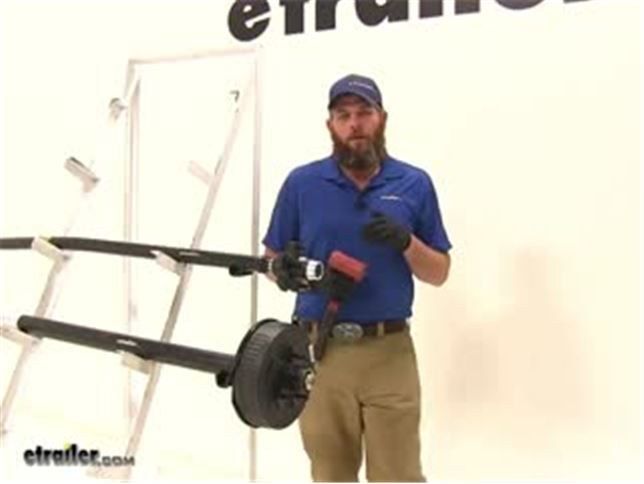

Videos are provided as a guide only. Refer to manufacturer installation instructions and specs for complete information.
Video Transcript for Trailer Bearings Races Seals and Caps Rebuild
Speaker 1: Today we're going to take you through the rebuild process on a couple of hubs. We've got an idler hub, and here we've got a hub and drum assembly. Works with electric rigs, but this can also work for just standard discs, if you've got a disc brake style setup.Basically what we're going to show you is how to get all of the bearings out. How to remove the seal. How to remove the race's if they're damaged, then get them replaced in the proper manner. We'll show you how to use an easy loop hub, which we have here.The first thing we are going to need to do is, get the grease cap off the end.
It can have either a rubber plug in it like this one does, or it can be a solid metal cap.These are pressed fit in there, basically by tapping on them on the back side. To remove them, a deadbolt hammer is typically what we're going to use. We're just going to start tapping as we go around. You'll see a little separation start right here, and slowly it'll work it's way off.Now the next step's going to vary a little bit depending on your axle setup. Do you see this is going to have a keeper that goes around the nut.
And that prevents that from being backed off, or removed. A lot of times you'll have a castle nut, which will have just little tabs that stick off, and there will be a cotter pin that passes through it. Just depending on your application, you need to get the keeper for the nut off. This style we just kind of pry out. A cotter pin you would just remove of course.Once we have that off ...
We'll start to take off the nut here, and the washer that's in behind it. Now yours should look a whole lot more dirty than this. There should be a lot of grease packed in, and through the hub, this one's brand new. We thought it'd be nice to show you the components before the grease was on .. Of our washer that comes off.And then here we're going to have our outer bearing.
Continue to pull that. We're gonig to have our inner bearing here. That sits in the backside of the hub. And we didn't put it in yet, we will show you how to put it in. But a seal would typically be covering the backside here. We'll show you how to use a seal removal tool, or another tool. To get that pried up and out. To get an access to that inner bearing.Now for a drum style like this, that process for disassembly is going to be just the same. One thing to keep in mind if you're using a disc brake setup. You'll have to remove the caliper before the disc is going to come off.Now once we have the spindle exposed, as we said this is going to be really greasy. We want to get all the grease removed, and the first thing we'll do is inspect it. We want to make sure that it looks just like what we have here. Everything's nice and smooth. We don't see any kind of discoloration, or any marring on the metal. Indicating that our bearing's got hot.If you do have any of those symptoms, at this point it's time to replace those bearings. You don't want to repack them. Get new bearings, and put in there. You might have a bearing that's come apart in here. Another surface to ensure is in good condition, is where your seal is going to go. That helps seal all the grease inside of our hub. With a damaged or broken seal, that grease is going to seep out. Either out of the hub, or in this case into our brake assembly.Now if your axle has brakes, we're also going to check the disc. Make sure it doesn't have any issues, or your hub. And this is going to be a hub and drum assembly. The brakes are going to ride on this machine surface. You're going to check that for signs of excessive heat, discoloration, or cracking. And this is our magnet surface. We'll check that surface for the same issues.Now inside the hub regardless if it's a disc brake, it's a drum brake like this. Or just a standard idler style hub. You're going to have an outer race. Would be right here, it's a small tapered piece of metal your bearing sits in, and rotates on. That's basically the outer portion of the bearing.You have the same thing here on the backside. This is called the inner race. Now if those show any signs of wear, overheating, or cracking. Those are also something we'll need to replace, which we'll show you how to do in just a minute.Now, with your brake assembly exposed, if you do have electric brakes like we have here. It's a good idea to check all the components for wear, cracking, maybe missing pieces. Check your pad thickness to make sure those are in good shape. Basically if you have a non working brake assembly and you put everything back together, you're just going to have to take it apart and do it all over again to get back to the brake assembly. This gives you a really good option to be able to change them out.And most applications are going to use a four, or maybe a five bolt flange to hold them in place. And you'll just remove the lock nuts, or sometimes you'll have a hex nut with a lock washer. You want to remove those, and then simply slide your assembly off after you cut the wiring.The friction material itself should also be checked for any kinds of cracking, or overheating. If you have any grease inside the system at all, it's likely it's gotten on those pads. It's a good idea to get those changed. Now as far as the removal of the races go, it's going to be just the same whether we're using an idler style hub like we have here. A drum brake like we have here. You can basically see where the idler is, here in the middle of the hub. It's going to go all the way around there, and we just have this extra material here to provide our braking surface.Now if you're doing a disc brake style job again, it's going to be just the same here with the races living inside of the actual hub portion. You'll just have the discs there for the brakes to make contact. We're going to use this little bit smaller one, it's a little bit easier to manage to show you how to get these out. We've talked about where the races are. The outer here, the inner being closer to the inside, but on the backside of the race there's a little lip. That lip's meant to stick out just a little bit further than the hub, and provide us an area to put our tool on, and help to drive that out.If you look all the way through there on that inner race, you'll see that little lip that sticks out just from the hub slightly, and it gives us enough area to use our tool on. Now generally to remove these you're going to use a punch, similar to this. Some guys will use a screwdriver. Or a piece of pipe. If you have a piece of pipe that's small enough to fit inside of that diameter, you can take that down through and allow it to rest on that lip.Use our punch, and then just need a hammer. And we'll start working that out. We're going to tap all the way around. Kind of equally, and evenly apply the force to get it to come on out of the bottom for us.You can see now as it starts to come out there's going to be a little gap created between the hub and the race. And we can just keep going, bringing it on out. Then you can inspect the inside of the hub surface there. Make sure no damage or anything has occurred, and repeat that same process for the outer race if you plan on removing and replacing that one.Now in the outer flat edge, you can see we're going to have our tapered edge on this side. If we roll our race over to the flat side, typically there's going to be a manufacturers part number on there. That will help you identify which race it is, that you need to go back in your system. If those are rubbed off, worn off, if you can't read them. You can measure the outside, to outside diameter of the race here. It's a good idea to use a micrometer to get it exact.Now here's your basic micrometer. And again, the outside of the race is what we're going to need to measure. You want to go . I set the thickest point there. Looks like this one's going to be about 1.98. That's going to be the measurement you'll want to supply.Now while we've got this out, let's also look at the proper way to measure our bearing. Instead of the outside for the bearing, we need to measure the inside diameter. That's going to be pretty simple. Let's pull that out, find the largest measurement we can. Which here, looks like it's going to be 1.03. With that information, we'll be able to get the correct bearing, and the correct race, so they'll fit together properly and make a full bearing kit for us.Now here's the race, we're going to show you how to get this put back in. Basically just going to press fit inside of our hubs. We need to get it down on there. Kind of like that. And you'll have a couple options. A lot of times you're going to see do it yourself or at homer, just going to use a wooden block. Just place it on there. That's going to get you started, but at that point you'll struggle in getting it to go all the way down into it's seat.Now to take care of that problem, there are several seal drivers that are available. Seal and race drivers that are available out there on the market. It's designed to fit down inside of our race, inside of our hub and get it down there where it needs to go. This is part number ptw83020, has several different sizes, even if you have multiple trailers it's going to do the job.Now the side with the angle on it, is designed to fit down inside of our race. If we use the other side, that's going to be for driving your seal into place. Just want to hold it, and take it on in with your hammer. You'll see, you just want to insure that our race is all the way up against that line on the hub where it's supposed to mate to.Now when it comes time to pack your bearings you're going to have several different ways of doing this. You can just use your hand, is the traditional method. That's going to be the method probably reserved for the very occasional trailer work kind of situation. If you do it once or twice a year, probably get away with it that way.Next you would go to a, kind of a sandwich funnel style almost. If you look inside of there, you can see the bearing. It's located between the two pieces. Just use a grease gun. Start filling that with grease, and that's going to fill our bearing for us. And the third, with this one you're just going to place your bearing down and in. It should be pretty close to center. And then we've got our cone her that's going to go down and secure that.Now I think this style, wastes a little bit more grease than what this style will. This has a dust cap. You can see, you can keep your grease in there, put your dust cap on there and save it for later use. This will be if your going to do it every couple years. And this particular style would be if you're a more regular user.Let's start by showing you how to use a bearing packer. Similar to this. Again, we've just got our grease inaudible 00:11:07 here on the top. And then just slowly start to fill it. Now I like this style quite a bit. I think even regular users might enjoy it, because you can get a really quick visual look at that bearing. You're not going to have to overdo it, or have to much grease.You can kind of see in there now, we're starting to get grease to come out of it. Couple more pumps, we'll be good. You can see we've got grease coming out all the way around. Where all of our bearings are. Got a little bit of excess there. Just take that around the outside of it. And then we should be able to lift it off. And now you can see what we we're talking about. Just a little bit of excess there, that you're just going to wind up wasting.Now we'll take our bearing, we're going to place it right down in our race. And then we'll cap off the back with our seal. Right now our seal's going to fit in just like our race did. It's going to have a little bit of a pressure fit to it. Now very often in this situation, I see people using the four by four method. Kind of here, just placing that on and tapping it. As an option though, if you do have one of these. You can see that's designed to fit right on the top of the seal. And help drive it in.The biggest thing here is, just going to be getting it driven in squarely. You can see, this side's in a little bit further than this side. I'm going to start this side first. Now since we didn't have the opportunity to show you before, we're going to take a look at pulling a seal. Now this is a seal puller, we carry this on our website part number ptw1219. This is meant to hook underneath the seal. And then you kind of pull up on it, and just like our race you'll have to work all the way around that edge. Just bringing it out a little at a time.If you don't have that available. Another option would be a screwdriver. You just kind of get that under the seal, and turn it. And see, that'll allow you to also pop that out. We've taken care of our race. Our inner bearing. Our seal. The last component, before we put our hub back in place is going to be our outer bearing. Now with this bearing, I'll show you the hand packing method.This is definitely . Slightly dirtier method than the bearing packer. When we get grease on our hand we want to look at the larger side of the bearing. This is the smaller side. We have a larger side In between the inside and outside there's a gap. We can see our rollers in there. We want to grab that, and use that gap and shove grease inside of it. Now this is going to take a little bit, you want to work in the same spot until you get the grease pushed all the way through. We can see on the top there we've got a little bit starting to come through.And once we push it in the bottom, and you see it start coming out the of the top in those little drips, it's going to indicate that, that section's fully packed. Just need to work all the way around their outside edge now and do the same thing. Alright, once that's all the way around . The bearing will be ready for use.Now one more thing I like to do. We can see our inner bearing there, and our outer bearing. Well between the two, got a pretty big gap in there. If you'll take a . Pretty good amount of grease. We're just going to go all the way around. See how we can go all the way around the inside and just line that really well. The more grease we have in here, the less chance we have of any moisture getting in there, which can cause corrosion, rust, pitting. Pretty much things we do not like when it comes to bearings, races, and hubs.Put plenty of grease in there. And then this one does have the easy lube spindle, that'll even fill it in more. Now we can get our assembly slid on. I like to keep my thumbs on that outer bearing, just to prevent it from . inaudible 00:15:28 pushed off there. Now we can put on the original hardware that we removed, in taking off our hub the first time. In our case, we had our washer and our nut.Now most commonly you'll see pliers similar to this being used. We basically want to get that tightened down. Once it's fully tightened down you'll feel some resistance in the hub. We back it off just slightly. That'll give us a little bit more freedom of motion there. Something you don't want however . Is any movement in, or out on your hub. You want to be sure that everything is compressed, and you don't have what's called end play. Which would be the play in and out.Once we've got that set, then you'll put on whatever tight keeper yours came with. Get that put back in place. Now with an easy lube style hub, you're going to place your grease gun on the end, and then you can just fill the remainder of that hub up.Now for your typical applications, you're either going to have a solid cap, or a cap that'll have a rubber plug in it. A solid cap's going to be for an axle without the grease inaudible 00:16:51 here on the end. Goes on there. Just knock it on with your rubber mallet. Same with the one with the plug. Just gives you a removable area there, be able to cap that off.We'll show you how to put that on. Now as alternatives as well, a lot of times on boat trailers and marine kind of situations. You'll see a bearing buddy. This is going to apply a little bit of pressure on the grease, you'll fill it up. This kind of comes out just a little bit. That applies constant pressure on the grease to make sure we don't have any air, or anything like that. Then there is also an oil bath hub available. Now this is going to be for use with seals that are going to be designed specifically for oil bath use. You'll have to change that seal.We're using a double lip seal. There are also single lip seals available. Of course a double lip seal is going to give you just a little additional security. Keep that in mind when you order. But let's get this knocked on there now so you can see how that works. We just want to take the cap, we're going to center it. This is going to be very similar to what we did with the seal. And then just gently start tapping it around the outside. And it'll seep down on there for you.It's really going to be the same thing that you'll do with any of the end caps. Now with this side done, it's a good idea to take care of all the other hubs. Get them all on the same maintenance schedule. And as long as you'll periodically check the grease, take your trailer out for a trip occasionally. Just to keep everything lubricated. It should extend the life of these parts, and give us years of good service.
Customer Satisfaction Score:
97% were satisfied with this product
3% of customers were not satisfied
- etrailer mistake
- Wrong item was ordered
Customer Reviews
Oil Seal - 9103309
Average Customer Rating: 4.9 out of 5 stars (29 Customer Reviews)

Bought new axel parts and brakes bigger wheels for my boat trailer. My existing axel was 20 years old and never was adequate for the weight it hauled causing wheel bearings to wear out and the chance of loosing a wheel. This was the most economical way to repair as a new trailer was so expensive. All the parts I needed were available and went together beautifully. Very happy with etrailer, this is not the first time I have ordered from them great option for any parts you need.

Very good seal. The only time we've had to replace them is when a bearing was overloaded and overheated the hub, resulting in overpressurization and seal blowout. Otherwise, I've got a 26K trailer running 6 of these over the past 10K miles with no issues.
I have received several different orders from trailer in the last couple weeks. Everything from a B&W fifth wheel hitch to trailer brake assemblies and lastly, axle seals. Everything received was very professional with excellent helpful service when help was requested. The seals that I just bought were exactly half price from what they would cost from a local vendor. Outstanding products as well as service!!!
I’m very happy with everything I purchased from etrailer. Everything was correct and fit perfectly. I’m very impressed with the service and their professionalism and knowledge of what they sell. I will definitely be ordering from them again.
I haven't has a chance to install them yet, but looking at the product it appears to be high quality. The customer service was excellent. My only complaint was the shipping time and costs, also product had a delay in transit. This caused me to not be able to work on the trailer as planned. Over all great to deal with company... Thanks for the help.
Great seals, used for a grease to oil-bath hub conversion. 5,000 miles and not a hint of any leaks.
Exact replacement for my Four Winns boat trailer.
Purchased oil seal- 9103309 for a spare part for my fifth wheel. Great Customer Service....
These seals are a little more expensive but do a good job of keeping grease in the bearings and out of the brakes.
Justin finally got it right talked to three people and got three different seal numbers but thanks Justin

All parts ordered were of excellent quality, Thanks!

PERFECT FIT AND GREAT PRICE

The right seal

A great seal
delivery on time,the correct parts,and i will be using your help again!!!----thanks ron
Good seal at a reasonable price.
Great product and fast shipping
See what our Experts say about this Redline Trailer Bearings Races Seals Caps
- Replacing A Seal Number 10-47 On A 2000 National RV TropicalWe do have a replacement for your 10-47 seal. The seal you are looking for is the # 9103309. This is the Dexter seal number 010-047-00 which we have confirmed to be identical.
view full answer... - Is There An Issue With Seating Grease Seal Slightly Below Hub Face?There is not an issue with installing the grease seal # 9103309 you were looking at 1/16" below the face of the hub. It will still seal against the grease seal surface on your axle, though you will want to make sure to not force the seal down to far as you can press it down against the bearing and race and cause issues there. I included a video showing the grease seal, inner bearing and race, and outer bearing and race being installed on on a hub for you to take a look at.
view full answer... - Recommended Oil Seal for Damaged Trailer Stub AxleFor your 412920 seal replacement, I recommend the Oil Seal # 9103309. This is the strongest seal we offer as a replacement for your EZ Lube axles. They are a tight seal intended for oil use but will also work with grease and be a stronger seal than a typical grease seal. If these seals doesn't work, then I recommend replacing your spindles.
view full answer... - Converting From Drum to Disc Brakes On a 2020 Grand Design Momentum with 7K AxlesIn order to convert the electric drum brakes on a 2020 Grand Design Momentum to hydraulic disc you can indeed use the Kodiak Disc Brake Kit part # K2HR79 which have oil bath lubrication. That said, you will need a list of other components which I have attached for you. Disc Brakes: part # K2HR79 (1 Per Axle) Inner Bearing: part # 25580 (2 Per Axle) Outer Bearing: part # 02475 (2 Per Axle) Seal: part # 9103309 (2 Per Axle) Brake Actuator and Lines: part # CAR-HBA16-2 (1) part # 9579-01...
view full answer... - Removal and Installation of a Unitized Oil Seal for a Trailer Oil Bath HubUnitized oil seals such as # 10-63 for example are different than regular grease seals. Unitized seals have an inner part that stays fixed to the spindle on the axle and its outer case rotates with the trailer hub. You would remove and reinstall a new one the same way you would with a regular seal. The best tool to use for unitized seals is a seal removal tool which you should be able to get at a local auto parts store. Once you pry out the old seal, place the new one in the hub. Use a...
view full answer... - How to Identify Correct Replacement Grease Seals and How to Install ThemThe best and easiest way to identify a replacement grease seal (or bearing for that matter) is by the original part's reference number. The linked photo shows the typical appearance and location of these part numbers on seal, bearings, races. It also shows where to measure your spindle if the part number is not available. Note that measuring spindles requires a precision digital caliper to measure to the nearest thousandth of an inch. I have linked you to an article and a video on the...
view full answer... - Correct Replacement Bearings for Boat Trailer with Oil Lubrication HubsI do have options for you but we can't look up bearings for any one specific trailer, you'll need to find the axle tag and or pull apart the hubs and find the bearing numbers. Please note, most of our bearings can be used with oil or grease, the seal is what determines oil or grease compatibility. The Bearing Kit part # BK3-100 is designed for 5,200-7,000 lb axles and you can use the Oil Seal part # 9103309 for oil lubrication compatibility.
view full answer... - Replacement Oil Bath Hub Seal for 22333TCThe correct replacement grease seals for your # 22333TC seals is part # RG06-070 for a grease hub or part # 9103309 for oil hubs. This includes two double lip seals and they have the same inner diameter, outer diameter and thickness as your current seals.
view full answer... - Choosing Between Oil and Grease Seals for Dexter 5.2K AxleThe seals # 9103309 and # GS-2250DL have the same inner and outer diameters (2.250" ID and 3.376" OD) but they are used for different applications. Use the seal # 9103309 if you have an oil bath setup but you'll want to use the seal # GS-2250DL if your hubs use grease. The seal is a little different for either application which is why they are specific. These do line up with what you find for a typical 5.2K axle.
view full answer... - How to Find the Correct Replacement Oil Seal and Oil CapI have a solution for you, but it looks like the oil cap itself is what is cracked and not the oil seal. I recommend taking the cap off and making sure that it's actually the seal and not the cap that is cracked before proceeding any further. Once you determine which part is actually damaged, you'll need to take some measurements on the inner and outer diameter (oil seals) or just the outer diameter (oil caps) to determine which replacement part you need. An oil seal like the Redline...
view full answer... - How To Determine Which Replacement Bearings and Grease Seal Are Correct For Boat TrailerThere are two different ways to determine which replacement bearings and grease seals will fit your boat trailer. The first is removing the hub and looking for the bearing numbers stamped on the face of the bearing as shown in the included picture of the # L44649, and looking for any part numbers stamped on the face of grease seal. If your bearings/grease seal is worn to the point that you cannot read the numbers then you will need to use digital calipers # PTW80157 to precisely measure...
view full answer... - Converting Grease Hubs to Oil Bath Hubs on Fifth Wheel TrailerSince you have bearings # 25580 and # 14125A the entire hub and drum assembly to convert it to oil bath hubs is # 8-219-9UC3-A. These are 8 on 6-1/2, 12 by 2 inch hubs and include the bearings, races, seal, oil cap, wheel bolts and lug nuts. We don't carry the hubs without the bearings. Our prices can be found on the product pages.
view full answer... - Replacement Bearings and Races for Single Axle Trailer with National Oil Seal 412920Sounds like you will need the # 15123 bearing and # 15245 race for that bearing. For the # 25580 bearing, you'll need the # 25520 race. For the oil seal you would need part # 9103309 which is the exact same as your 412920. We do not have a full kit of this so they are all sold separately. I have linked all the above mentioned products to this page for your convenience.
view full answer... - Suspension and Disc Brake Upgrade for Grand Design Momentum 398MI have some great options for you to upgrade the Grand Design Momentum 398M such as the Roadmaster Comfort Ride Leaf Spring Suspension Kit part # RM-2460-2570-3 which will help drastically increase ride quality/performance and the HydraStar Disc Brake Kit w/ Actuator for Triple Axle Trailers part # HSE7K-TR1 which will increase stopping power. They can be converted to oil bath with the Kodiak XL ProLube Oil Bath Hub Body and Cap part # XLPROLUBE2440 and Oil Seal part # 9103309. Unfortunately,...
view full answer... - How do I replace the oil seal on my trailer?First, to remove the seal, turn the hub over with the wheel studs facing up on a hollow cinder block or on a couple of 2x4s. You will need to remove the seal by using a 1" wood dowel rod or scrap lumber that will fit into the center of the hub. Place the dowel rod against the inner bearing and knock out the bearing with a mallet in a circular motion. The wood will force the seal out without nicking the bearing or race. Be careful not to damage the hub and race when prying it out. The best...
view full answer... - How to Correctly Position Oil/Grease Seal in Trailer HubAn oil seal like Redline part # 9103309 installs in the back side of the hub (the side nearest the trailer's frame) with the sides or "legs" of the seal inserted into the hub's bore. This means that the flat metal surface of the seal will face the trailer frame. The linked photo of a seal will show you both sides and indicates the direction in which it should be installed into the hub. I have linked both an article and video on seals that may be helpful to you.
view full answer... - Unitized Oil Seal for Trailer Hubs Installation and Lowest Price PledgeThe item you selected, while having the right measurements, is not a unitized oil seal. We do carry the 10-63 unitized oil seal (see link). Installing the seal requires pressing the seal flush or slightly into the hub. I normally use a wooden block to seat the seal flush with the back side of the hub. We have an install video for you to watch that shows installation of a grease seal. Normally flush installation is correct unless Tie Down Engineering specifies differently.
view full answer... - Correct Replacement Oil Seal 225255UC for Ranger Boat TrailerThe correct replacement for the Oil Seal 225255UC is the Oil Seal part # 9103309. These both have a 2.24/2.25" inner diameter and 3.37" outer diameter. They are also designed for use with oil bath hubs.
view full answer... - How Far in a Trailer Hub Should the Grease Seal GoWhen installing a seal at the back of a hub the outer part of the seal will need to be flush with the hub. I have linked a video that should help. You could watch the whole video or fast forward to the 1 minute, 50 second mark to see the seal installation.
view full answer... - Kodiak Disc Brake Kit for 2018 Jayco 377RLBH 5th WheelI would be happy to help you set up your 2018 Jayco 377RLBH 5th wheel for disc brakes. We don't have a complete kit available with all the lines and bearings you will need but I can give you all of the part numbers. The Kodiak Disc Brake Kit - 13" item # K2HR79 you were looking at is a great set of disc brakes that will be perfect for your Dexter 7k axles. Depending on the region of the country you are in and how much traveling you do on salty roads I recommend spending a little extra on...
view full answer... - How do you Install a Grease Seal After Replacing Bearings or Re-Packing GreaseThe seals should be replaced each time you re-pack the bearings. When you take the hub or drum apart, toss the old seal and use a fresh one when you reassemble and pack with new grease. It install the new seal, gently tap it in a hammer, evenly working around the seal. We have a really good video on removing, disassembling, greasing and re-assembling a drum that will be very helpful. The seal install portion can be found at the 10:50 mark.
view full answer... - Oil Seal For Dexter Axles Matching Size Of Dexter 10-36 Grease SealFor an oil seal matching the inside and outside diameter of the 10-36 grease seal, you will want the Unitized Oil Seal for Trailer Hubs # 10-63 for your Dexter axles. You can also use the Oil Seal # 9103309 confirmed to fit Hayes axles of the same size. Hayes was bought out by Dexter.
view full answer... - Proper Direction To Install A Hub Seal On TrailerWhen replacing a grease seal, the metal part of the seal will face towards the inside of the trailer and the rubber part of the seal will face toward the back side of the wheel. The air side of the seal is the flat side of the seal and faces out when it is installed in the hub. The item you selected, Oil Seal, part # 9103309, is designed to be used with hubs that use gear lube instead of grease. If you can send me the inner and outer bearing numbers that are stamped on the bearings, and...
view full answer... - What Size Grease Seal, Bearings, and Dust Cap Are Needed for a 1982 Starcraft 1506 XL Tent CamperTo determine the correct parts for your 1982 Starcraft Starlite 1506 xl tent camper, you will have to remove the hub from the trailer and either get part numbers from the inner and outer bearing, and grease seal or measure the spindle in 3 places and the hub in two places. I have included a photo showing the places to look for part numbers and places to measure if part numbers are not visible on your bearings and seal. If you need to measure, a dial caliper will be needed to get accurate...
view full answer...
Do you have a question about this Trailer Bearings Races Seals Cap?
Info for this part was:







At etrailer.com we provide the best information available about the products we sell. We take the quality of our information seriously so that you can get the right part the first time. Let us know if anything is missing or if you have any questions.







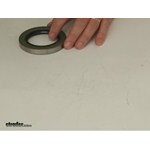






















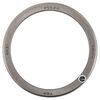

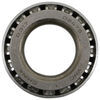

















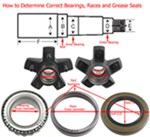
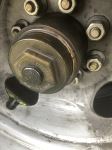
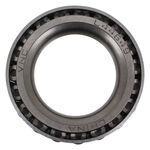
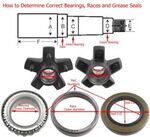
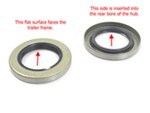
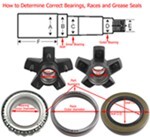
Thank you! Your comment has been submitted successfully. You should be able to view your question/comment here within a few days.
Error submitting comment. Please try again momentarily.